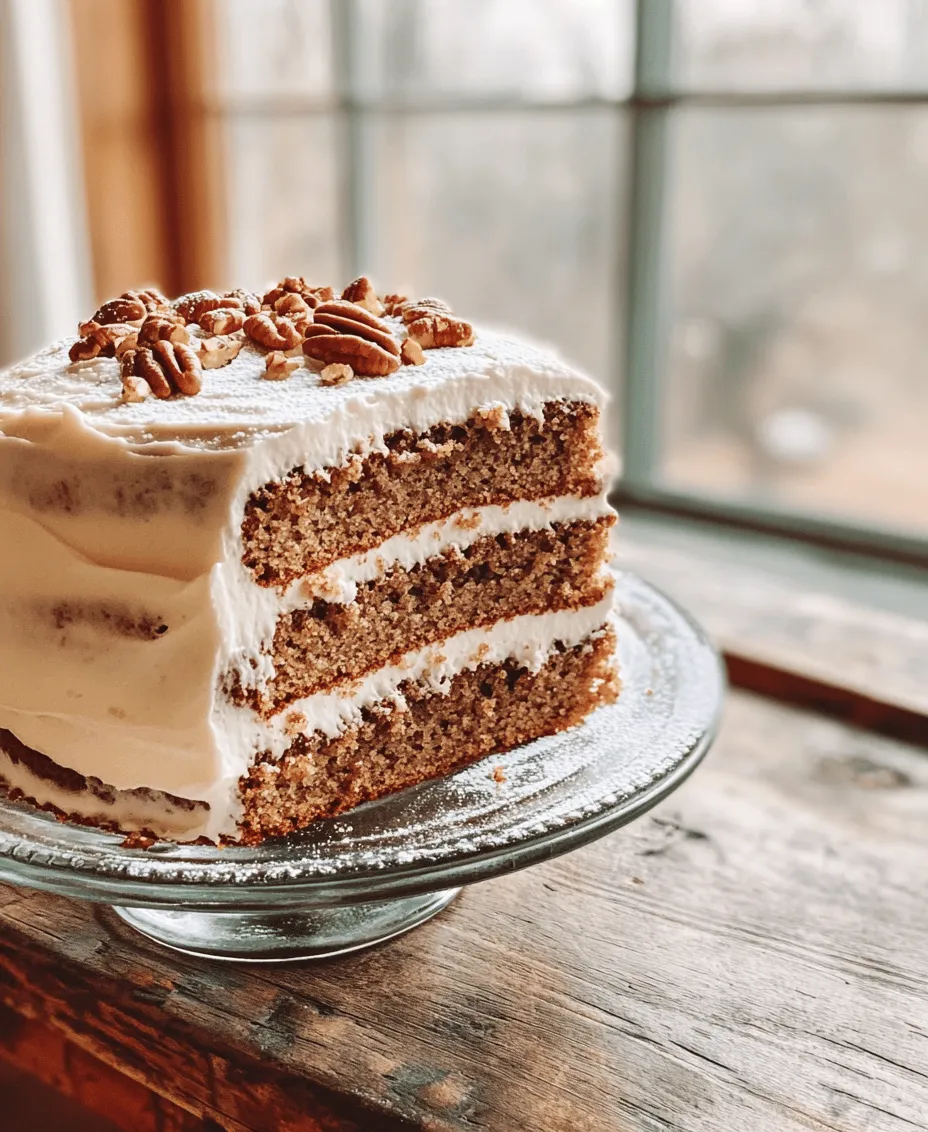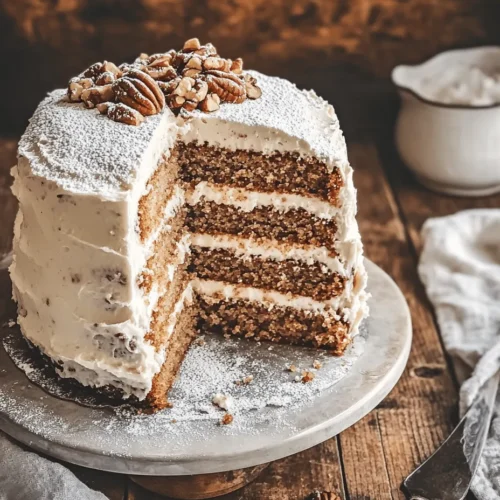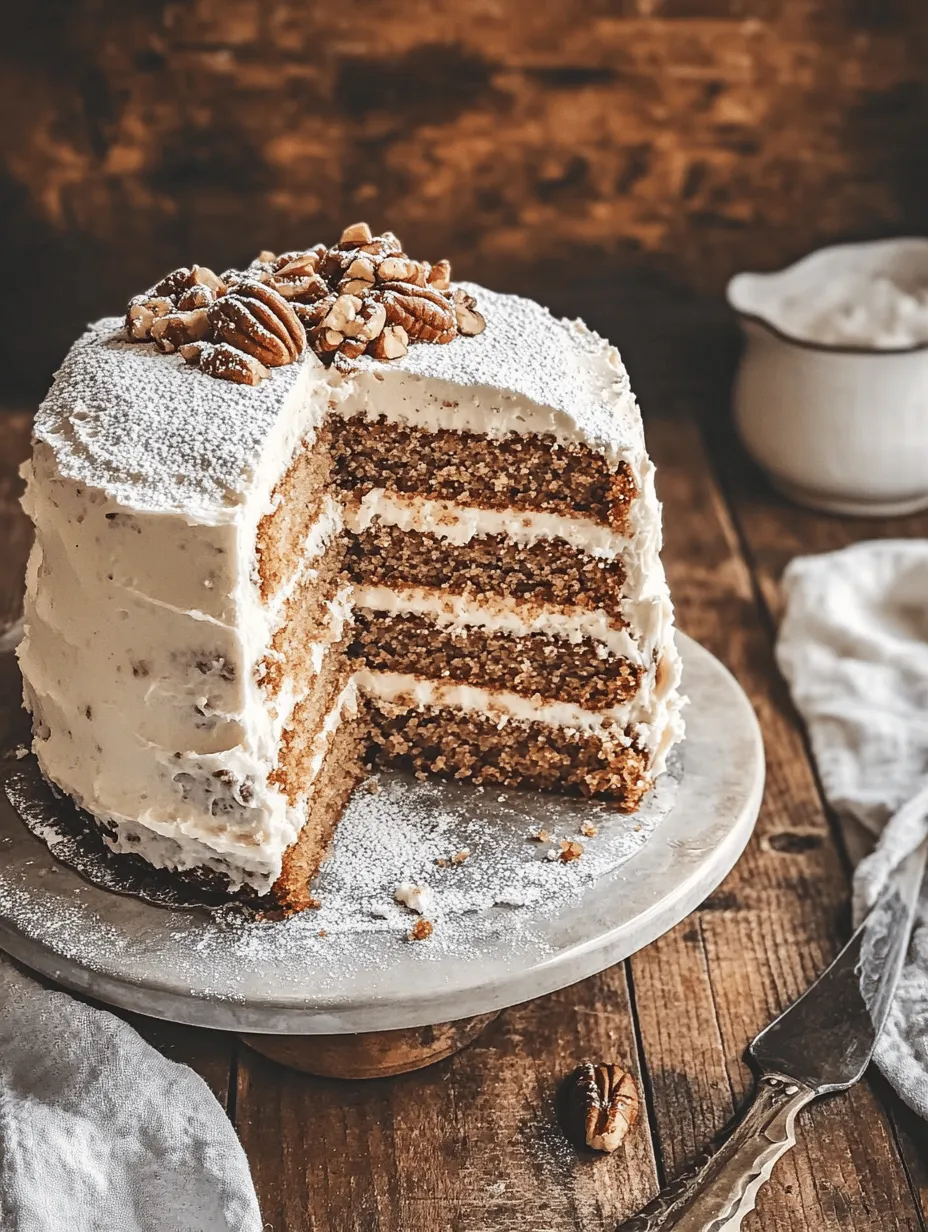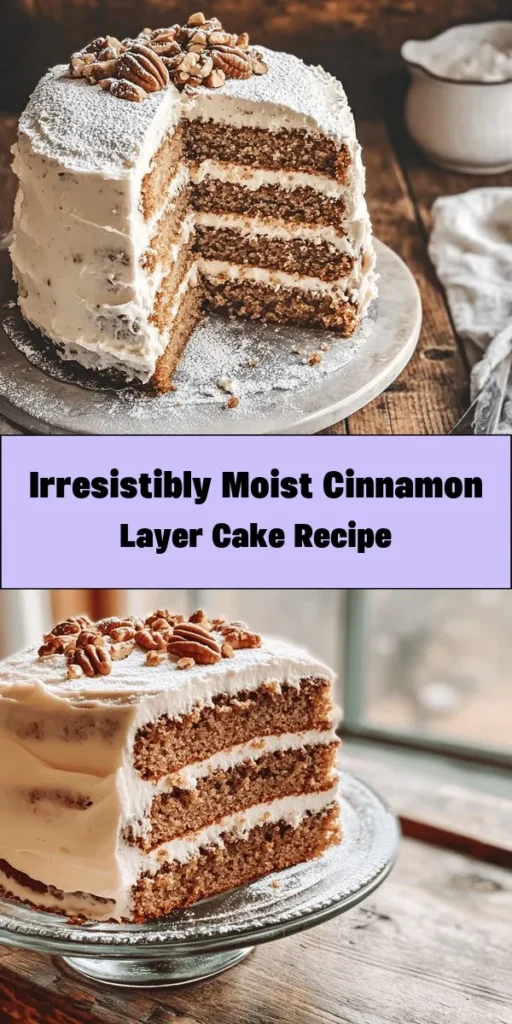Introduction
There’s something truly special about homemade cakes that store-bought options simply can’t replicate. The aroma that fills the kitchen as it bakes, the anticipation of that first slice, and the joy of sharing a lovingly crafted dessert with friends and family are all part of the cake-baking experience. Among the myriad of cake recipes available, the Moist Cinnamon Layer Cake stands out with its comforting flavors and inviting textures.
Imagine sinking your fork into three layers of soft, fluffy cake infused with a warm blend of cinnamon, ginger, and nutmeg. Each bite is a delightful balance of sweetness and spice, making it a perfect treat for any occasion, be it a cozy family gathering, a festive celebration, or even a casual afternoon tea. This cake’s versatility is one of its most appealing features; it can be dressed up with a rich cream cheese frosting for a special occasion or enjoyed plain with a cup of coffee on a quiet Sunday morning.
In this article, we will guide you through the process of creating your own Moist Cinnamon Layer Cake, from understanding the essential ingredients to the initial preparation steps. Whether you’re an experienced baker or a kitchen novice, you’ll find that this recipe is both approachable and rewarding.
Understanding the Ingredients
To create a Moist Cinnamon Layer Cake that is rich in flavor and texture, it’s critical to understand the role of each ingredient. Here’s a detailed breakdown of what you’ll need:
Flour: Importance in Cake Structure
The foundation of any cake is flour, and for our Moist Cinnamon Layer Cake, all-purpose flour works beautifully. Flour provides the necessary structure and stability to the cake. When mixed with liquids, the proteins in the flour develop gluten, which gives the cake its shape and chew. For the best results, it’s essential to measure the flour correctly; too much can lead to a dense cake, while too little might not provide enough structure.
Baking Powder and Baking Soda: Their Roles in Leavening
Leavening agents like baking powder and baking soda are crucial for providing the cake with its light and airy texture. Baking powder is a combination of an acid and a base that reacts when mixed with liquid and heated, producing carbon dioxide bubbles that expand during baking. On the other hand, baking soda requires acidity (like buttermilk) to activate. Together, these agents help the cake rise, ensuring each layer is perfectly fluffy.
Spices: The Warm Flavor Profile Provided by Cinnamon, Ginger, and Nutmeg
The star of the show in our Moist Cinnamon Layer Cake is undoubtedly the spices. Ground cinnamon adds a warm, sweet flavor that is synonymous with home baking. Ginger and nutmeg contribute additional layers of warmth and complexity. Together, these spices create a comforting aroma that evokes memories of family gatherings and holiday celebrations. It’s essential to use freshly ground spices when possible, as they provide a more vibrant flavor profile.
Butter and Sugars: Creating Moisture and Sweetness
Butter is a key ingredient that adds moisture, richness, and flavor to our cake. It’s best to use unsalted butter so you can control the salt levels in your recipe. The creaming method, where butter is beaten with sugars, helps to incorporate air into the batter, contributing to its light texture.
When it comes to sugars, a combination of granulated sugar and brown sugar is often used. Granulated sugar provides sweetness and structure, while brown sugar adds moisture and a hint of caramel flavor. This blend ensures that the cake is not only sweet but also has the perfect moist crumb.
Eggs and Buttermilk: Their Contributions to Texture and Richness
Eggs play a vital role in baking, providing structure, moisture, and richness. They also help emulsify the batter, ensuring that the fats and liquids blend together smoothly. Buttermilk, a key ingredient in this recipe, adds acidity that activates the baking soda, helping the cake rise. It also tenderizes the crumb, making for a softer cake.
Optional Nuts: Adding Crunch and Additional Flavor
While not necessary, adding chopped nuts such as walnuts or pecans can elevate the texture of the Moist Cinnamon Layer Cake. Nuts provide a delightful crunch that contrasts with the soft cake layers and can enhance the overall flavor profile. If you choose to include nuts, be sure to chop them finely so they incorporate evenly throughout the batter.
Preparation Steps Explained
Now that you understand the importance of each ingredient, let’s move on to the preparation steps that will set you up for success in creating this delicious cake.
Prepping the Kitchen: Importance of Mise en Place
Before you begin baking, it’s essential to prepare your kitchen for a smooth process. This technique is known as mise en place, which means “everything in its place.” Gather all your ingredients and tools before you start, including mixing bowls, measuring cups, and baking pans. This not only makes the process more efficient but also minimizes the risk of forgetting any ingredients.
Preheating the Oven: Why It Matters
Preheating your oven is a crucial step in baking. It ensures that the cake starts baking at the right temperature, which is essential for proper leavening. For our Moist Cinnamon Layer Cake, preheat your oven to 350°F (175°C) so that it’s ready when you are. This step also helps to create an even texture and helps the cake rise properly.
Greasing and Flourishing Pans: Ensuring Easy Release
To prevent your cake from sticking to the pans, it’s important to grease and flour them properly. Use a generous amount of unsalted butter to coat the bottom and sides of each pan, then sprinkle a light dusting of flour, shaking off any excess. Alternatively, you can use parchment paper for lining the bottom of the pans for an even easier release. This step is crucial in ensuring that your cake layers come out intact and ready for stacking.
Mixing Techniques: Ensuring the Right Texture
One of the key factors in achieving a perfect Moist Cinnamon Layer Cake is the technique used in mixing the ingredients. Mixing too much can lead to a dense cake, while under-mixing can result in uneven texture. Here’s how to get it just right:
Creaming Method: Achieving Light and Fluffy Batter
Start by creaming together the softened butter and sugars until the mixture is light and fluffy. This process incorporates air into the batter, which is vital for leavening. Use an electric mixer for best results, beating on medium speed for about 3-5 minutes. You’ll know it’s ready when the mixture is pale and fluffy.
Incorporating Dry Ingredients: The Importance of the Alternating Method
Once your butter and sugar are creamed, it’s time to add the dry ingredients. It’s essential to mix the dry ingredients (flour, baking powder, baking soda, and spices) in a separate bowl before incorporating them into the batter. To maintain the cake’s light texture, use the alternating method: add a portion of the dry ingredients, followed by some buttermilk, and repeat until everything is combined. This technique prevents overmixing and ensures a tender cake.
Folding in Spices and Nuts: Techniques to Avoid Overmixing
Finally, if you’re adding nuts, gently fold them into the batter along with the spices using a spatula. Be careful not to overmix at this stage; you want to incorporate the ingredients without deflating the batter. Fold until everything is just combined, and you’re ready to pour the batter into your prepared pans.
With these initial steps and a thorough understanding of the ingredients involved, you’re well on your way to creating a Moist Cinnamon Layer Cake that is sure to impress. In the next part of this article, we’ll guide you through the baking process, how to assemble the layers, and the perfect frosting that will take your cake to the next level. Stay tuned for the delightful continuation of this baking journey!

Baking the Cake
Once your cake batter is ready and divided into the prepared pans, it’s time to get baking! Monitoring the baking process is crucial to achieving that perfect, moist cinnamon layer cake you desire.
Monitoring the Baking Process: Tips for Checking Doneness
Baking is a science, and knowing when your cake is done is key to ensuring it retains its moisture and texture. Here are a few helpful tips to keep in mind while your cake is in the oven:
1. Oven Temperature: Always preheat your oven to the required temperature (typically 350°F or 175°C for layer cakes). An oven thermometer can help ensure accuracy, as many home ovens can be off by as much as 25°F.
2. Baking Time: Start checking the cake for doneness about 5-10 minutes before the minimum baking time indicated in your recipe. For a standard layer cake, this is usually around 25-30 minutes.
3. Visual Cues: Look for a golden-brown color on the top of the cake. The edges should start to pull away slightly from the sides of the pan, indicating that it’s set.
Using a Toothpick for Testing
The classic method for checking cake doneness is the toothpick test. Here’s how to do it correctly:
– Insert a toothpick or a cake tester into the center of the cake. If it comes out clean or with a few moist crumbs (not wet batter), your cake is done. If it comes out with wet batter, return the cake to the oven for a few more minutes and test again.
Understanding the Signs of a Properly Baked Cake
In addition to the toothpick test, there are other signs of a properly baked cake:
– Springy Texture: Gently press the center of the cake with your finger. If it springs back, it’s done. If it leaves an indentation, give it more time.
– Aromas: The delightful smell of baking cinnamon should fill your kitchen. As the cake nears doneness, the scent will intensify.
Cooling the Cakes: Importance for Maintaining Moisture and Preventing Crumbling
Once your cakes are perfectly baked, remove them from the oven and let them cool in the pans for about 10-15 minutes. This cooling period is vital because it helps the cakes firm up, making them easier to remove without crumbling. Here’s how to cool them properly:
1. Transfer to Wire Racks: Carefully run a knife around the edges of the pans to loosen the cakes. Invert them onto wire racks to cool completely. This allows air to circulate around the cakes, preventing sogginess.
2. Keep Covered: If you’re not frosting the cakes immediately, cover them with a clean kitchen towel or plastic wrap to retain moisture.
Frosting and Decorating Options
Now that your cakes are cooled, it’s time to frost and decorate. The right frosting can elevate your Moist Cinnamon Layer Cake from delicious to extraordinary.
Traditional Cream Cheese Frosting: Recipe and Preparation Steps
Cream cheese frosting is a classic pairing with cinnamon cakes. Its tangy flavor complements the sweetness of the cake beautifully. Here’s a simple recipe for traditional cream cheese frosting:
Ingredients:
– 8 oz cream cheese, softened
– 1/2 cup unsalted butter, softened
– 4 cups powdered sugar
– 1 teaspoon vanilla extract
– A pinch of salt
Instructions:
1. In a large mixing bowl, beat the softened cream cheese and butter together until smooth and creamy.
2. Gradually add the powdered sugar, mixing on low until combined. Increase speed to high and beat until fluffy.
3. Add the vanilla extract and a pinch of salt, then mix until fully incorporated.
Alternative Frosting Options: Buttercream or Whipped Cream Suggestions
If cream cheese frosting isn’t your style, consider these alternatives:
– Buttercream Frosting: A rich and sweet option, buttercream is made with butter, powdered sugar, and vanilla. You can also add a hint of cinnamon to echo the flavors of the cake.
– Whipped Cream: For a lighter topping, whipped cream is perfect. Simply whip heavy cream with a bit of sugar until soft peaks form, and dollop generously between and on top of the cake layers.
Simple Dusting with Powdered Sugar: A Minimalist Approach to Presentation
If you prefer a more understated look, a light dusting of powdered sugar can be an elegant finishing touch. Using a fine sieve, lightly sprinkle powdered sugar over the top of the cake just before serving.
Layering Techniques: How to Achieve a Professional-Looking Cake
To achieve a beautiful layered cake, follow these steps:
1. Level the Layers: Before stacking, ensure your cake layers are even by trimming the tops with a serrated knife.
2. Use a Turntable: If you have one, a turntable can help you frost the cake evenly.
3. Layering: Start with one layer on a serving plate, spread a generous amount of frosting on top, and place the second layer on top. Repeat this for as many layers as you have.
4. Crumb Coat: Apply a thin layer of frosting around the entire cake to seal in crumbs. Chill the cake for 30 minutes, then apply a final layer of frosting for a smooth finish.
Serving Suggestions
The Moist Cinnamon Layer Cake is versatile and can be enjoyed on various occasions. Here are some great ideas for serving:
Best Occasions to Serve the Moist Cinnamon Layer Cake
– Birthdays: This cake makes a delightful birthday treat, especially for those who love spices and a rich flavor profile.
– Holidays: Its warm cinnamon flavor is perfect for fall and winter celebrations, like Thanksgiving and Christmas.
– Casual Gatherings: Whether it’s a weekend brunch or a coffee date with friends, this cake pairs beautifully with casual get-togethers.
Pairing Ideas: Beverages That Complement the Cake
To enhance the enjoyment of your cake, consider pairing it with beverages that complement its flavors:
– Coffee: A cup of freshly brewed coffee, whether it’s espresso or a creamy latte, pairs perfectly with the rich flavors of the cake.
– Tea: Spiced chai or a robust black tea can bring out the cake’s warm cinnamon notes.
– Milk: A classic pairing, a glass of cold milk never goes out of style when enjoying a slice of cake.
Storage and Shelf Life
To keep your Moist Cinnamon Layer Cake fresh and delicious, proper storage is essential.
Proper Storage Techniques: Keeping the Cake Fresh
– Room Temperature: If you plan to eat the cake within a few days, store it in an airtight container at room temperature. This will keep it moist and flavorful.
– Refrigeration: If you have leftovers or the cake is frosted with cream cheese frosting, it’s best to store it in the refrigerator. Cover it with plastic wrap to maintain moisture.
Freezing Options: How to Freeze Layers or Fully Assembled Cakes
If you want to save some cake for later, freezing is a great option:
1. Freezing Layers: Wrap each cooled cake layer in plastic wrap and then in aluminum foil. Store in the freezer for up to three months. When ready to use, thaw in the fridge overnight.
2. Freezing Assembled Cake: If the cake is fully decorated, place it in the freezer for about an hour to set the frosting. Once firm, wrap it in plastic wrap and aluminum foil. It can be frozen for up to three months.
Recommended Shelf Life: How Long the Cake Can Be Kept Without Losing Quality
When stored properly, your Moist Cinnamon Layer Cake can last:
– At Room Temperature: 3-4 days.
– In the Refrigerator: Up to a week.
– In the Freezer: Up to three months, maintaining its quality when thawed correctly.
Conclusion
The Moist Cinnamon Layer Cake is a delightful treat that combines rich, warm flavors with a tender crumb to create a truly unforgettable dessert experience. With its versatile frosting options and elegant presentation techniques, this cake is perfect for any occasion, whether it be a birthday celebration, holiday feast, or a simple afternoon gathering.
We encourage you to try this recipe and experience the joy of baking something special for your family and friends. Baking is not just about the end result; it’s about the love and happiness shared through homemade treats. So gather your ingredients, preheat that oven, and get ready to create a cake that will surely impress and delight! Enjoy your baking adventure!



